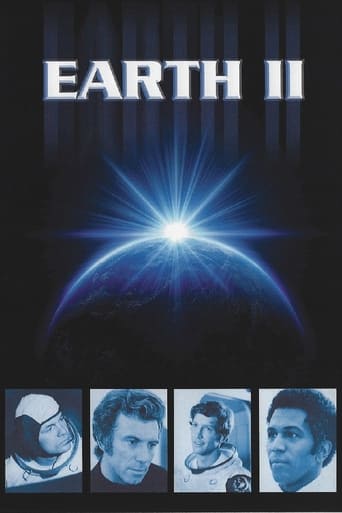

Really Surprised!
... View MoreDreadfully Boring
... View MoreThe film was still a fun one that will make you laugh and have you leaving the theater feeling like you just stole something valuable and got away with it.
... View MoreIn truth, there is barely enough story here to make a film.
... View MoreEveryone is talking about how EARTH II was ahead of its time with special effects, scientific imaginings, and the like. I was, however, a little more down to earth. The people who worked up this film did not have their feet on the ground.Here's the premise: An international project sends up a huge space station and populates it with about a hundred people from various nations. The USSR is represented but not China - because the Chinese had a bad attitude about it. Instantly the US President (Lew Ayres) tells the inmates of this space station that they are now a new and independent nation, he (evidently without the advice and consent of Congress) is recognizing it as a new nation and he's going to have the UN make it a member state. This is absurd on a number of levels include any business about the exchange of ambassadors.Additionally, the technology pretty much does their thinking for them. In a ship-wide video discussion of a crucial problem of international relations, the ship's computers analyze each person's argument and put subtitles on the screen with disparaging labels about their contribution -- e.g. "Appeal to authority".Apart from this, the interesting stuff (the special effects) is about a Chinese nuclear satellite that is being used to the homelands of the inmates of this space station.So, comic book logic, impressive special effects.
... View MoreI saw this TV-movie when it aired in 1971. I liked it then and saw it a few times in syndication. Now I own it on DVD.The premise is that an orbiting space station is created by the United States and then is set up as an independent nation named Earth II. This nation is completely democratic, with a council that executes policies for the station. If someone disagree, they can challenge that decision and all the citizens can vote.A situation occurs where the "no weapons" policy is challenged. A nuclear bomb is orbit around Earth, and passes close to the station on every orbit. The citizens have to make a choice whether to interfere with the bomb, in order to protect themselves and Earth.The movie stars Gary Lockwood of "2001: A Space Odyssey" fame, Hari Rhodes and Scott Hylands. In a supporting role is Gary Merrill. Since this was probably a pilot, the guest cast included Tony Franciosa and Mariette Hartley.While the film is dated and some of the science not so accurate, it is still very well done and for science fiction fans, should be seen.One complaint is that there are two excellent actors playing Chinese representatives. These are Soon-Tek Oh and James Hong. They are uncredited, which is unfortunate.
... View MoreThis is a very rare made for TV movie with a great story and excellent special effects. The only thing that might be considered wrong about this film is that even though it is supposedly set in the future, this film is now very much dated. This film was made during the height of the Cold War and at a time relations between The U.S., the then Soviet Union and China were not very good. In fact, the U.S. is almost looked at as a pawn in the struggle between the other two super powers. However, this film does provide a good glimpse at the future and how space travel could eventually be routine and the possibilities of global cooperation in outer space.
... View MoreThis was sort of a cross between 2001 and Marooned. It made a very early attempt to make a scientifically accurate sci-fi series. The station was populated by people from all nations. They set up thier own government, and they led very politically correct lives. Any adult could disagree with the station's government and put the disagreement to a vote via an interactive TV. The show had some very interesting ideas about the future development of technology. Early in the show, a national election takes place by people turning on their home lights, and an spaceship in orbit counts the votes. Worth seeing if you can.
... View More